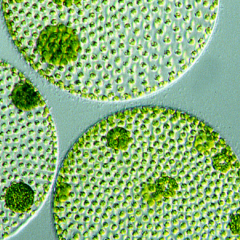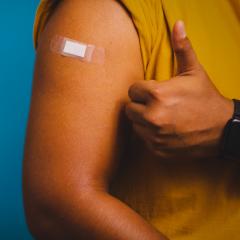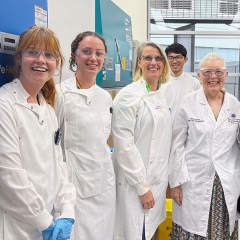Leading researchers from Australia and Saudi Arabia, including IMB researchers, are coming together to understand the genetic makeup of corals and how they might respond to climate change.
Proudly supported by Rio Tinto, Bioplatforms Australia (BPA) and the ReFuGe 2020 Consortium, convened by the Great Barrier Reef Foundation, the Sea-quence research project will uncover core genetic data for Great Barrier Reef and Red Sea corals with the aim of using this information to help protect them from climate change.
The project will be delivered in two parallel but connected parts – one in Australia and one in the Red Sea in Saudi Arabia.
IMB's Professor Mark Ragan (pictured below) is one of three researchers leading The University of Queensland's contribution to the ReFuGe 2020 Consortium, alongside Professor Ove Hoegh-Guldberg and Dr Gene Tyson, while Professor Sean Grimmond sits on the Coral Genomics advisory panel.
At today’s launch in Brisbane, Great Barrier Reef Foundation Chairman, Dr John Schubert AO said: “Coral reefs are important ecosystems that support the livelihoods of an estimated half a billion people across the world.
“Climate change places coral reefs at risk through warmer water temperatures and more acidic oceans.
“Unfortunately our knowledge of coral resilience, their capacity to adapt and the circumstances under which they can adapt to climate change is limited.
“Through Sea-quence we can start to bridge this critical knowledge gap by generating data on a wide scale across the Great Barrier Reef and the Red Sea”.

Xabier Irigoyen, Director of the Red Sea Center at King Abdullah University of Science and Technology (KAUST), said: “Red Sea corals live in extreme conditions compared to those on the Great Barrier Reef and comparative information between these will enhance our understanding of how and why some corals are more resilient.
“We at KAUST are excited to be a partner in this exciting research and the reef management knowledge it will generate.”
The project will see Bioplatforms Australia facilities, such as the Australian Genome Research Facility; work with the coral research community to deliver much needed coral DNA data repositories.
Director of Bioplatforms Australia, Dr Sue Meek said: “The advance of genome sequencing in other fields is making it possible for us to apply these powerful techniques to understanding and preserving natural ecosystems like the Great Barrier Reef.”
Doug Ritchie, Rio Tinto Group Executive Strategy, said: “Rio Tinto has a long history of involvement with the Great Barrier Reef Foundation and is proud to support projects designed to help protect and preserve the Great Barrier Reef.
“Rio Tinto is proud to support landmark research projects like Sea-quence and Future Reef MAP – a first of its kind study to monitor ocean chemistry along the length of Australia's Great Barrier Reef Marine Park using existing vessel movements announced earlier this year.
“The Reef is an asset for all Australians and we all have a role to play to ensure the sustainability of this iconic natural wonder for future generations.
“Our investment in adaptation research in an area of international significance like the Great Barrier Reef compliments our investment in low emission coal technologies.”
Dr Russell Reichelt, Chairman of the Great Barrier Reef Marine Park Authority said: “Presently only two coral species in the world have had their DNA sequenced.
“This research project will sequence the genomes of 10 coral species - providing five times the data currently available and identify which genes help corals adapt to climate change, and which species contain these genes.
“As such, Sea-quence is an important first step in research, specifically designed to equip reef managers with knowledge that will help them maintain the diversity and function that makes coral reefs, like the Great Barrier Reef, so special in the face of climate change.”
About the IMB
The Institute for Molecular Bioscience (IMB) is a research institute of The University of Queensland that aims to improve quality of life by advancing personalised medicine, drug discovery and biotechnology.
For more information, to donate to or collaborate with Professor Ragan's or Professor Grimmond's labs, please call (07) 3346 2132 or email advancement@imb.uq.edu.au
ReFuGe 2020 consortium partners
The Great Barrier Reef Foundation, James Cook University, the Australian Institute of Marine Science, the University of Queensland, the Great Barrier Reef Marine Park Authority, the King Abdullah University of Science and Technology (Saudi Arabia) and the Australian National University.
About The Great Barrier Reef Foundation
Established in 1999, the Great Barrier Reef Foundation (GBRF) engages its network to identify, shape, fund and oversee research that will underpin the protection and preservation of coral reefs. Focusing on innovative thinking, the Foundation has, with its partners in business, science and philanthropy raised more than $24m for research, so that the Reef, and our interactions with it, can adapt.
About Bioplatforms Australia
Bioplatforms Australia (BPA) is a not-for-profit company funded largely by Australian government funds from the Education Infrastructure Fund’s Super Science Initiative, leveraged with state government and research partner contributions. BPA’s mission is to build a national research infrastructure network and promote increased collaboration and integration between scientists. BPA will provide the ReFuGe 2020 consortium with $500,000 as part of its national investment in the creation of large scale DNA, protein and metabolite datasets as enabling resources for modern bioscience.
About Rio Tinto
Rio Tinto is a leading international mining group headquartered in the UK, combining Rio Tinto plc, a London and New York Stock Exchange listed company, and Rio Tinto Limited, which is listed on the Australian Securities Exchange.
Rio Tinto's business is finding, mining, and processing mineral resources. Major products are aluminium, copper, diamonds, thermal and metallurgical coal, uranium, gold, industrial minerals (borax, titanium dioxide and salt) and iron ore. Activities span the world and are strongly represented in Australia and North America with significant businesses in Asia, Europe, Africa and South America.



